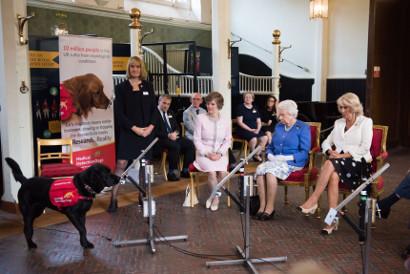Research with dogs who 'sniff' for cancer shown at Buckingham Palace

OU research with dogs who can find cancer cells in biological samples has been demonstrated to the Royal Family, in the presence of Her Majesty the Queen, this week (6 June 2018).
Dr Clara Mancini, Senior Lecturer in Computing and Communications at the OU, and Head of the OU’s Animal-Computer Interaction Lab, was invited to Buckingham Palace to celebrate the 10th anniversary of the charity Medical Detection Dogs.
Screening body fluids for disease: the signaling challenge
Dr Mancini has been collaborating with the charity since 2013, when she began researching ways to support the work of dogs who can detect the odour of cancer and other diseases from volatile compounds in body fluids, such as urine, sweat or breath.
During this time, Dr Mancini learnt how the conventional signals taught by humans to dogs to alert them to the presence of volatiles in a sample, such as sitting down in front of a ‘positive’ sample, limited the potential of the dogs’ work.
“These conventional signals clarify the dogs’ decision for human convenience but limit their ability to provide information on what they find,” Dr Mancini said.
“Firstly, these conventions only enable dogs to express binary responses, while differences between samples may be more nuanced, possibly indicating different stages of disease. Secondly these signals are not consistent with how dogs spontaneously respond to odours of interest, adding a ‘translation overhead’ to their already cognitively demanding work and interfering with their performance,” she added.
Addressing the challenge: a new canine computer interface
In a bid to explore new approaches, Dr Mancini and her technical team, developed a canine computer interface, which uses sensor technology to capture the sniffing behaviour of the dogs as they investigate the samples, revealing interaction patterns that correlate with the samples’ content.
Eliminating human bias
The research will now be developed further, and Clara and her team will use machine learning techniques to classify these patterns automatically in real time, so that the system itself can reward the dogs when they are correct, and thus eliminate some of the human bias from the training and screening process. The researchers are currently running a trial with Medical Detection Dogs to gather data for the development of learning algorithms that can automatically interpret the data.
“Ultimately, this work will contribute towards ongoing efforts to develop ‘artificial noses’ that can do the tests and that can be widely deployed,” said Dr Mancini.
Hear what Dr Mancini has to say and watch how the dogs work in the video:
Watch a video about Dr Mancini’s earlier work with Medical Detection Dogs
Quarterly Review of Research
Read our Quarterly Review of Research to learn about our latest quality academic output.

Contact our news team
For all out of hours enquiries, please telephone +44 (0)7901 515891
